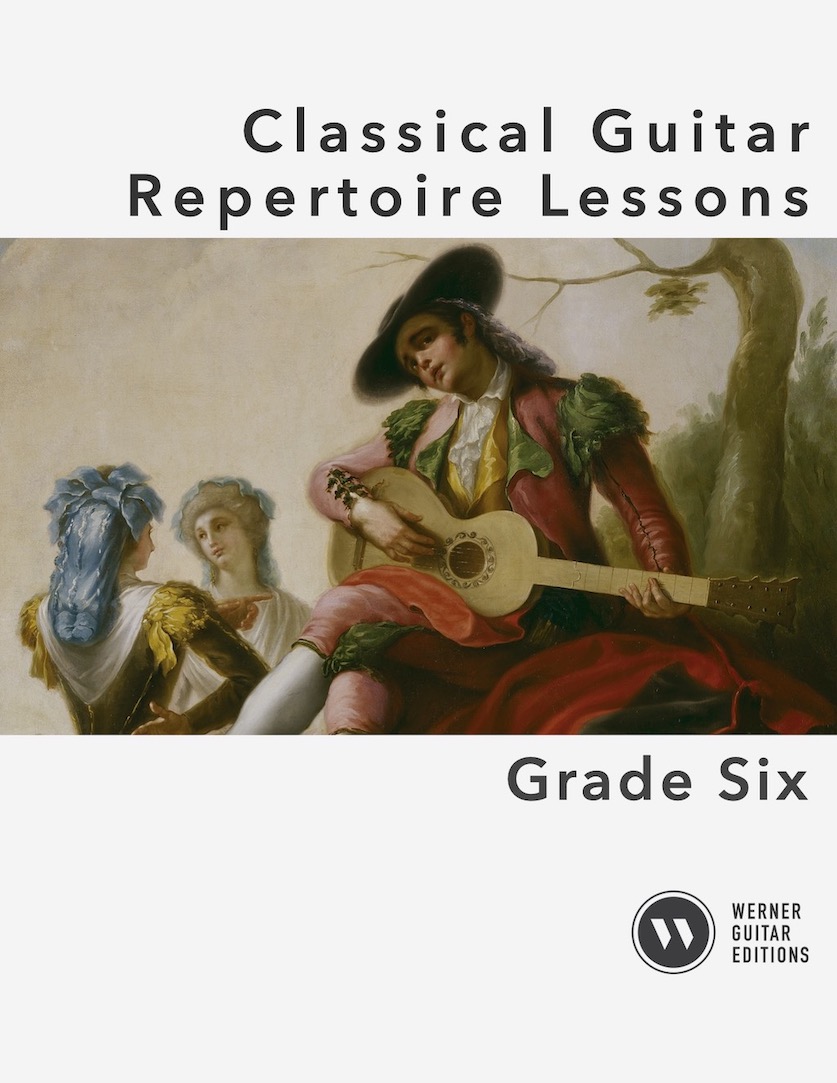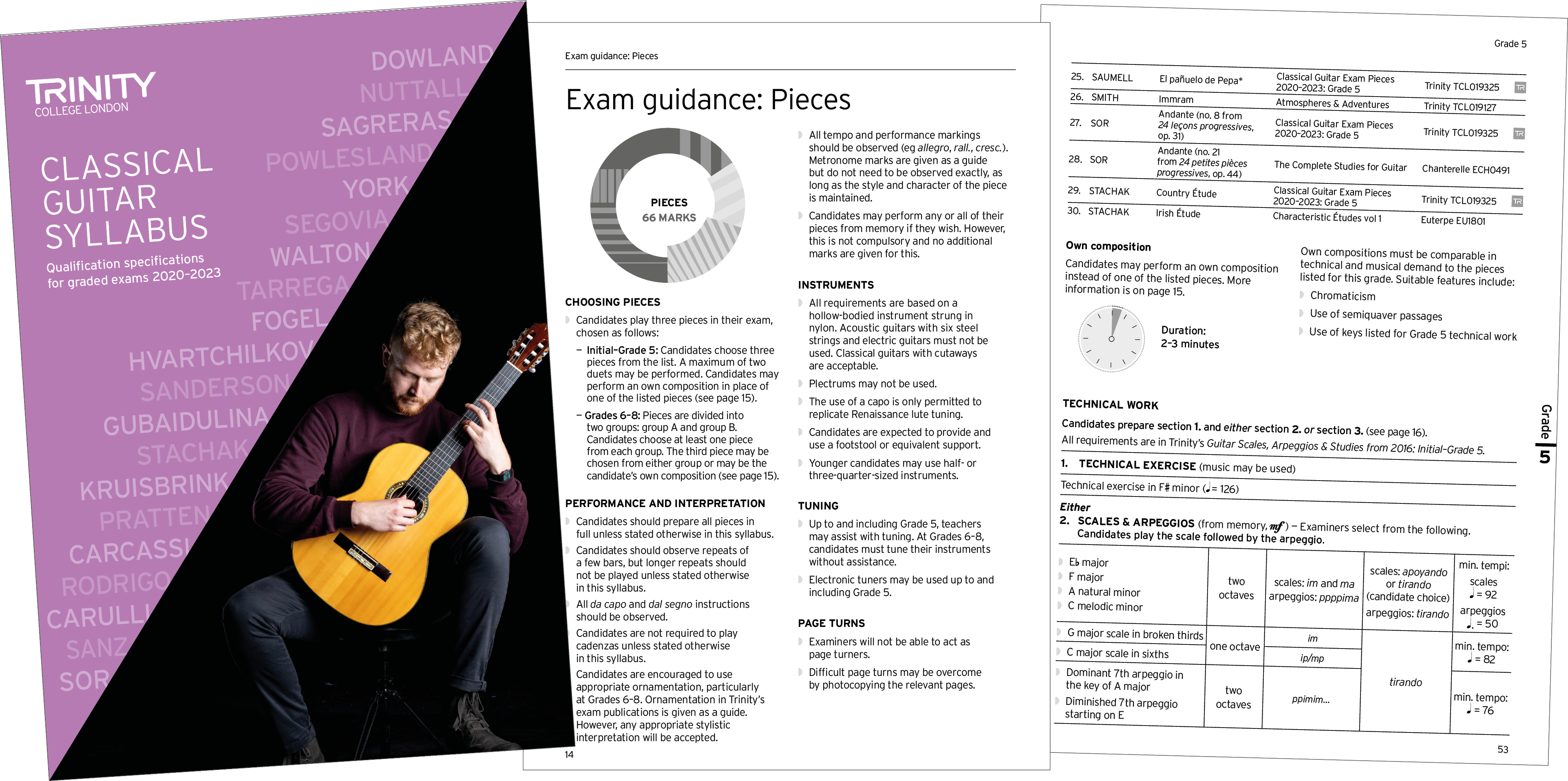There are 8 grades in classical guitar. These levels delineate the escalating difficulty and technical proficiency required.
Mastering the classical guitar involves progressing through a structured sequence of grades, with each grade building upon the skills and knowledge acquired in the previous one. The grading system provides students with clear goals and benchmarks, facilitating both learning and teaching.
By working through these grades, typically offered through standardized exams by music institutions, guitarists develop a comprehensive skill set that includes sight-reading, technique, performance, and a nuanced understanding of a wide repertoire of classical guitar music. For anyone keen to learn classical guitar, understanding the significance of these grades is fundamental to both tracking progress and achieving mastery in this intricate and expressive instrument.

Credit: wernerguitareditions.com
Introduction To Classical Guitar Grading
Welcome to the introductory guide on Classical Guitar Grading. Embarking on the journey of mastering the classical guitar is both enriching and challenging. Whether a beginner plucking the first strings or an advanced player performing intricate compositions, understanding the various grades in classical guitar can offer a roadmap for progress and benchmarking. Let’s unravel the mysteries of the grading system, which not only standardizes learning approaches but also provides essential milestones for both students and teachers.
The Purpose Of Guitar Grading Systems
Guitar grading systems serve as a structured framework designed to guide learners through the complexities of classical guitar techniques and repertoire. Grades function like stepping stones, helping students to advance systematically through skill levels. While these gradings offer a sense of achievement and motivation, they also establish clear expectations for students and educators alike. Additionally, many grading systems are affiliated with certifications that can be essential for further musical education or professional pursuits.
An Overview Of Classical Guitar Grades
The classical guitar grading system typically comprises a series of progressive levels, starting from preliminary or introductory grades and moving up through advanced stages. Each grade outlines specific technical exercises, scales, and repertoire pieces that reflect the skill level expected to be mastered. Here’s a general breakdown of the grading levels in classical guitar:
- Initial Grades (Preliminary to Grade 2): Focus on basic postures, simple melodies, and the fundamentals of finger placement.
- Intermediate Grades (Grades 3 to 5): Develop more complex techniques and introduce a wider range of musical expressions.
- Advanced Grades (Grades 6 to 8): Involve advanced technical exercises, diverse musical styles, and performance skills.
- Diploma Levels: Post-grade 8, delve into professional training with an emphasis on performance and musicology.
Recognized Grading Organizations
Several reputable organizations worldwide set the standards for classical guitar grading. These include:
| Organization | Country | Notes |
|---|---|---|
| The Associated Board of the Royal Schools of Music (ABRSM) | United Kingdom | One of the largest music education bodies globally, offering assessments for a broad range of instruments. |
| The Royal Conservatory of Music (RCM) | Canada | Known for its comprehensive curriculum and internationally recognized standards. |
| Trinity College London | United Kingdom | Provides a flexible examination system with a focus on encouraging the individuality of the performer. |
These institutions not only conduct exams but also provide syllabi and learning materials that are extensively used by teachers and students alike. Diligence in preparation for each grade’s requirements guarantees a solid foundation and proficiency that is universally understood and respected within the classical music community.
Exploring The Structure Of Classical Guitar Grades
Welcome to Exploring the Structure of Classical Guitar Grades, a detailed look at how classical guitar players progress through various levels of proficiency. Navigating through the grading system can often seem daunting to newcomers. This system ensures that guitarists have a clear pathway for development, and it provides goals that motivate students to keep improving. Let’s dive into the world of classical guitar grades and understand what each level entails.
Typical Grade Levels And Progression
The classical guitar grading system typically consists of eight grades, starting from the initial Grade 1, which is perfect for beginners, up to the advanced Grade 8. Progressing through these grades requires dedication, practice, and a love for the instrument.
- Initial Stages (Grades 1-2): Foundation building with a focus on basic techniques and simple melodies.
- Intermediate Levels (Grades 3-5): Development of technical skills and more complex pieces of music.
- Advanced Levels (Grades 6-8): Mastery of challenging compositions, with an emphasis on expressiveness and technical proficiency.
Skills And Techniques Assessed At Each Grade
Each grade level assesses a range of skills and techniques that are critical for mastering the classical guitar.
| Grade | Technical Skills | Musical Techniques |
|---|---|---|
| 1-2 | Basic fingering, simple chords | Basic rhythm, dynamic control |
| 3-5 | Scale playing, arpeggios | Articulation, use of tone colors |
| 6-8 | Advanced techniques, e.g., tremolo | Musicality, interpretation, and dynamics |
Repertoire Requirements Per Grade
The repertoire for each grade is designed to reflect and enhance the skills required at that level. With a diverse range of compositions, students explore different styles and historical periods.
- Grade 1: Simple pieces from the Renaissance to the 20th century.
- Grade 2: Introduction to Baroque and Classical music.
- Grade 3: More varied repertoire, including Romantic and modern works.
- Grade 4: Emphasis on musical phrasing and stylistic awareness.
- Grade 5: Larger, more complex works that challenge technical and musical growth.
- Grades 6-8: Performance-level pieces that require a high degree of technical skill and emotional maturity.
Examining The Grading Process
Embarking on the journey to mastery in classical guitar includes a structured framework known as the grading process. This leveled system offers a methodical way for students to progress, showcasing their skills, and gaining recognition for their level of competency. Examining the grading process reveals the path taken by aspiring guitarists as they navigate through the various stages of their musical development.
The Role Of Examinations In Guitar Grading
Examinations are pivotal in the classical guitar grading system. They serve as formal assessments that validate a student’s proficiency and readiness to advance to the next level. Each grade presents a set of challenges, from elementary to advanced techniques, which students must proficiently demonstrate. These exams are typically conducted by recognized music boards, providing an objective and standardized measure of skills and accomplishments.
Preparing For Grade Assessments
Preparing for grade assessments demands consistent practice, dedication, and a thorough understanding of the material. Prospective candidates often engage in focused training, which may include:
- Learning specific pieces from the exam syllabus
- Mastering scales, arpeggios, and technical exercises
- Developing sight-reading abilities
- Enhancing musical interpretation and performance skills
Musical theory comprehension and aural tests are also integral parts of preparation, as they contribute significantly to a candidate’s overall evaluation.
Understanding The Grading Criteria
The grading criteria for classical guitar are designed to gauge the multifaceted aspects of a student’s musicianship. To achieve a grade, candidates must demonstrate:
| Technical Proficiency | Musical Expression | Theoretical Knowledge | Aural Skills |
|---|---|---|---|
| Accuracy in finger placement and plucking | Dynamics and phrasing interpretation | Understanding of musical notation and terms | Ability to recognize melodies and rhythms |
It is essential for students to be aware of the specific criteria for each grade as they can vary between examination boards. Typically, each grade builds upon the skills assessed in the previous one, ensuring a comprehensive development of guitar techniques and musicality.

Credit: www.thisisclassicalguitar.com
Beyond The Grades: Mastery And Professional Qualifications
Embarking on a journey through classical guitar grades is a structured way to develop proficiency, yet it’s just the beginning. Beyond the Grades: Mastery and Professional Qualifications are landmarks in a guitarist’s endless journey towards musical excellence. For those who look to transcend traditional grade levels, opportunities abound in the form of advanced diplomas and certifications, continuous education, and substantial professional development. This evolution not only refines skill and technique but also enriches artistic expression and performance prowess.
Advanced Diplomas And Certifications
Delving into the world of advanced diplomas and certifications opens doors to specialized knowledge and technique refinement. Prestigious institutions offer a variety of programs such as:
- Licentiate Diplomas (LTCL, LRSM, DipABRSM): Performance-based qualifications demanding a professional level of musical competence.
- Associate Diplomas (ATCL, ARSM, ABRSM): A bridge between high-level amateur and professional status, emphasizing performance and teaching skills.
Attaining these certifications signals a commitment to excellence and a readiness to engage with the musical community at a professional level.
Continuing Education And Professional Development
Continuing education and professional development are vital for classical guitarists, ensuring their skills remain relevant and cutting-edge. Opportunities include:
- Masterclasses with renowned guitarists.
- Participation in workshops focusing on specific aspects of performance, such as interpretation and technique.
- Enrollment in online courses to stay updated with the latest pedagogical methods.
Engaging in these activities not only sharpens one’s skills but also fosters vital connections within the classical guitar community.
The Significance Of Grades In A Guitarist’s Career
The importance of grades in a guitarist’s career cannot be understated. They serve as:
| Benchmark | Progress Indicator | Resume Highlight |
|---|---|---|
| Provide a standardized measure of skill level. | Track development and motivate toward higher levels of playing. | Demonstrate dedication and proficiency to potential clients or employers. |
As milestones of achievement, grades also aid in setting goals that promote a structured approach to learning and improvement. Ultimately, these marks of distinction are steps on the path to mastery and serve as a solid foundation for advancing through the ranks of professional qualifications.

Credit: resources.trinitycollege.com
Is There a Difference in Grades for Classical Guitar Compared to Electric Guitar?
When learning to play, students often wonder about the classical guitar versus electric guitar difficulty comparison. Classical guitar requires precision in finger placement and technique, while electric guitar often emphasizes expressive playing and effects. Each presents unique challenges, shaping the learning experience for aspiring musicians based on their chosen style.
Frequently Asked Questions For How Many Grades Are There In Classical Guitar
What Is The Highest Grade In Classical Guitar?
The highest grade in classical guitar through certification bodies like ABRSM or Trinity is Grade 8.
How Long To Get To Grade 8 Classical Guitar?
Achieving Grade 8 in classical guitar typically takes about 6-8 years of dedicated practice and instruction, depending on the student’s practice frequency and natural aptitude.
How Many Guitar Grades Are There?
There are typically eight grades for guitar exams, starting from grade 1 (beginner level) to grade 8 (advanced level).
What Is Grade 7 Guitar?
Grade 7 guitar signifies an advanced skill level in guitar performance, as defined by music examination boards like the ABRSM or Trinity College London. Students at this stage master complex pieces and technical skills.
Conclusion
Embarking on the classical guitar journey unveils a structured path through eight recognized grades. Each level marks a milestone, from beginner to advanced mastery. As students progress, they unlock new technical abilities and musical expression. Let this guide fuel your passion, helping chart a course through the enriching grades of classical guitar.
{ “@context”: “https://schema.org”, “@type”: “FAQPage”, “mainEntity”: [ { “@type”: “Question”, “name”: “What is the highest grade in classical guitar?”, “acceptedAnswer”: { “@type”: “Answer”, “text”: “The highest grade in classical guitar through certification bodies like ABRSM or Trinity is Grade 8.” } } , { “@type”: “Question”, “name”: “How long to get to Grade 8 classical guitar?”, “acceptedAnswer”: { “@type”: “Answer”, “text”: “Achieving Grade 8 in classical guitar typically takes about 6-8 years of dedicated practice and instruction, depending on the student’s practice frequency and natural aptitude.” } } , { “@type”: “Question”, “name”: “How many guitar grades are there?”, “acceptedAnswer”: { “@type”: “Answer”, “text”: “There are typically eight grades for guitar exams, starting from grade 1 (beginner level) to grade 8 (advanced level).” } } , { “@type”: “Question”, “name”: “What is Grade 7 guitar?”, “acceptedAnswer”: { “@type”: “Answer”, “text”: “Grade 7 guitar signifies an advanced skill level in guitar performance, as defined by music examination boards like the ABRSM or Trinity College London. Students at this stage master complex pieces and technical skills.” } } ] }